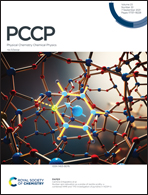Enhanced photocatalytic activity of the direct Z-scheme black phosphorus/BiOX (X = Cl, Br, I) heterostructures†
Abstract
Bismuth oxyhalides (BiOX), as a typical photocatalytic material, have attracted much attention due to their unique layered structure, non-toxicity and excellent stability. However, the photocatalytic performance of BiOX is limited by their weak light absorption ability and rapid recombination of photo-generated carriers. In the present work, first-principles calculations have been performed to comprehensively explore the structural, electronic and optical properties of black phosphorus (BP)/BiOX (X = Cl, Br, I) heterostructures, revealing the inherent reasons for their enhanced photocatalytic performance. By combining band structures and work function analysis, the migration paths of photo-generated electrons and holes are obtained, proving a direct Z-scheme photocatalytic mechanism in BP/BiOX heterostructures. Moreover, the BP/BiOX heterostructures have decent band edge positions, which are suitable for photocatalytic overall water splitting. Compared with single BiOX, the light absorption performance of BP/BiOX heterostructures is significantly improved, in which BP/BiOI exhibits the highest optical absorption coefficient among the BP/BiOX heterostructures. Meanwhile, the better carrier migration performance of the BP/BiOX heterostructures is attributed to the reduction in effective mass. The present work offers theoretical insight into the application of BP/BiOX heterostructures as prominent photocatalysts for water splitting.



 Please wait while we load your content...
Please wait while we load your content...